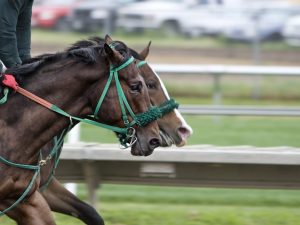By Ed McNamara
While more buds, flowers and leaves appear each day, this season of rebirth remains all about regrets. The latest sign of this false spring: On Friday, Pimlico Race Course became a drive-through testing site for COVID-19. Another sad tale of The New Abnormal: from hosting the Preakness to identifying coronavirus hosts.

Image by Bhakti Iyata from Pixabay
Last month, the Kentucky Derby and the Preakness were pushed back from May 2 and May 16, and the track shutdowns, postponements and delays keep piling up.
Aqueduct cut off its winter-spring meet and was repurposed as a field hospital for pandemic victims. Keeneland canceled its prestigious April meeting, Santa Anita went dark, and only California (just Los Alamitos), Florida, Arkansas, Oklahoma and Nebraska have live racing.
Churchill Downs delayed its April 25 opening until further notice, and its backstretch won’t open before April 28. Monmouth Park won’t race until Fourth of July weekend, two months late, and its barns are closed until June 1. Saratoga’s Oklahoma training track is unavailable until April 15. Belmont Park is still supposed to start up April 24, but we’ll see about that.
Tentative schedules are changing weekly, so don’t bother marking your calendar. Expect those dates to end up like messages scratched in the sand before the tide rolls in. This plague is a tsunami, and no one knows when it will ebb. There were signs Friday that the curve finally has begun to flatten in New York, America’s hardest-hit state, yet the same day the international death toll passed 100,000.
Five-time Derby winner Bob Baffert is doing his best to stay upbeat. Speaking of the shutdown at his Santa Anita base, he told NBC: “One thing good about it is I get to go to the track every day and train the horses. It keeps my sanity.
“Everything’s day by day, hour by hour. We all want to do what’s right and get through this thing. Hopefully, in a few weeks, maybe, we can see light in the tunnel.”
If any light does appear, it will be impossible to know the length of the tunnel. On March 29, President Trump said he believes sports can resume “sooner rather than later” while admitting “I can’t tell you a date.”
Now there are rumblings about reopening society as soon as next month, which could be disastrous. Lifting strict social distancing guidelines prematurely would undo many of the gains created by staying home. As New York Gov. Andrew Cuomo said, “Even though it is a grind and it is difficult, we have to stay with it.”
Like everything else in the world, the Triple Crown is up in the air. Besides the Arkansas Derby, which was switched from April 11 to May 2, the 3-year-old landscape is a blank.
“Trainers are in limbo,” TVG analyst Simon Bray said. “Nobody can make any plans. It’s a wait-and-see approach. I think we’re looking at a disjointed Triple Crown.”
It couldn’t be more discombobulated. Churchill is expected to designate more races as Derby preps and assign qualifying points, but that’s not possible without a template giving their dates and sequence.
“You know what, nobody knows yet,” Baffert said.
Even the order of the Derby, Preakness and Belmont isn’t certain. If the Derby is run Sept. 5 and the Preakness on Sept. 19, would the New York Racing Association be willing to stage the Belmont on Oct. 10? Few trainers pointing for the 1¼-mile Breeders’ Cup Classic a month later would use a 1½-mile marathon as a prep.
It’s possible that the Belmont, still scheduled for June 6, will occur before the other two. In a wacky year, could the finale come first? NYRA President and CEO David O’Rourke told bloodhorse.com Wednesday that “in the next few weeks” he should have a decision on the race.
Despite its stature, the Triple Crown is just a blip amid a crisis for humanity. The late Phil Bull, founder of Timeform’s speed ratings, loved racing but called it “The Great Triviality.” In the big picture, shutting it down for the rest of the year, or even longer if necessary, would be an acceptable casualty if it helped win the war against COVID-19.
If that’s what has to happen, so be it.
If you enjoyed this piece, check out other articles at our horse racing news section!
Ed McNamara is an award-winning journalist who has been writing about thoroughbred racing for 35 years. He has handicapped races for ESPN.com, Newsday and The Record of New Jersey. He is the author of “Cajun Racing: From the Bush Tracks to the Triple Crown” and co-author of “The Most Glorious Crown,” a chronicle of the first 12 Triple Crown champions.



